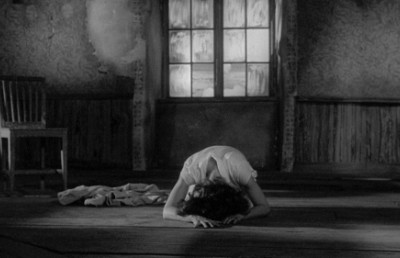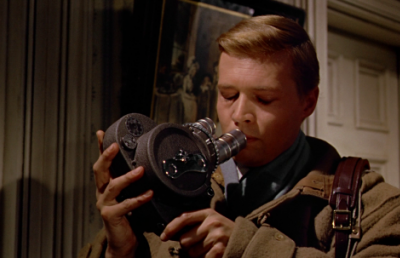Cinema as Thought: Teorema (Pier Paolo Pasolini, 1968) and Salo (Pier Paolo Pasolini, 1975)

Cinema as Thought is a “Deleuzean” concept. This philosophy states that cinema is not a language. According to Deleuze, cinema exhibits automatic or psychomechanical qualities and is basically a system of pre-linguistic images and signs. He points out: “Cinema considered as psychomechanics, or spiritual automaton, is reflected in its own content, its themes, situations and characters” (Deleuze 263). Cinema is like a machine or automaton that produces different sets of ideas. It functions like the conceptual development found in theoretical physics. He goes on to say that: “A theory of cinema is not about cinema, but about the concepts that cinema gives rise to and which are themselves related to other concepts corresponding to other practices, the practice of concepts in general having no privilege over others, any more than one object has over others … Cinema’s concepts are not given in cinema. And yet they are cinema’s concepts, not theories about cinema” (Deleuze 280). Therefore, cinema is a philosophy. In this sense cinema loses its metaphorical or metonymical character and takes on the nature of a theorem. To exemplify this point, let’s investigate the theorematic nature of two Pasolini films, Teorema (1968) and Salo (1975).
The thetic argument is that Teorema and Salo fall within the set of films that are categorized as “theorem films,” ones that don’t expound on the thematic values of the narrative but create new concepts where imagery is deduced from thought. In such films, sensory-motor situations break down and are replaced with formal connections of thought, the thought-image. Hence, the first step in this investigation will consist in looking at particular sequences and identifying the various shots that exhibit strong thought-image linkages, shots that seem to be deduced from one another as thought is deduced from thought in cognitive processes. The second task will be to show that the deductive processes in Teorema and Salo are different, exhibiting different convergence characteristics, including the possibility of non-convergence. There exists a duality or polarity condition between these two films, a condition that is based on the theorem’s functionality; while the social commentary art-house film Teorema manifests itself as a problematic embedded inside a theoretical structure where ideas converge to some extrinsic but uncertain thought-image, the horror art film Salo is non-problematic, nothing needs to be solved or proven because there is no exterior point of convergence for a thought-image to form. Salo is purely axiomatic and all ideas exist within its interior; and because of its purely axiomatic pole, it is also a Teorema morto (a dead theorem).
In the case of Teorema and an article written by Tony Cesare, wherein he states that: “A psychological analysis of the bourgeoisie, based on a historical theory and an empirical economic law, is Pasolini’s real theorem and not the metaphysical idea of the appearance of the sacred in reality. The theorem is a materialist one about the disappearance of the sacred from reality” (Cesare 22). The film begins with Paolo, the father of a rich bourgeois family and owner of a large factory, who decides to leave his entire business to the workers. Truly, the beginning of this story is really the ending at which point Paolo is seen wandering in the desert after leaving everything behind; and in despair and anguish, Paolo screams out as though he was dying because he realizes that his stable identity has been completely obliterated. On the surface, Paolo’s trauma seems to emanate from a deep religious experience. The apparent driving force of the film is centered on a mysterious stranger, with Christ-like characteristics, who arrives at the father’s bourgeois Milanese household. Once there, this unnamed guest manages to seduce, both physically and spiritually, the entire family; in doing so, the guest emotionally strips them of their individual bourgeois persona. The affectations caused by this young man (played to perfect seduction by Terence Stamp, once voted the “most beautiful man in the world”) on the members of the family are drastic self-transformations, or at least, deep introspective self-realizations. Pietro, the son abandons his vocation as a painter; while Lucia, the mother, starts a series of random sexual encounters. Then there is Odetta, the daughter, who sinks into catatonia; and interestingly, Emilia, the maid, becomes a saint. As mentioned before, Paolo, the father, hands his factory over to his workers because in a sense he loses his mind. But as soon as the film begins, the visitor leaves this disgruntled group; so in essence, his central role in the film is only catalytic. Indeed, the true driving forces within the story are the psychomechanics of their inner thoughts.
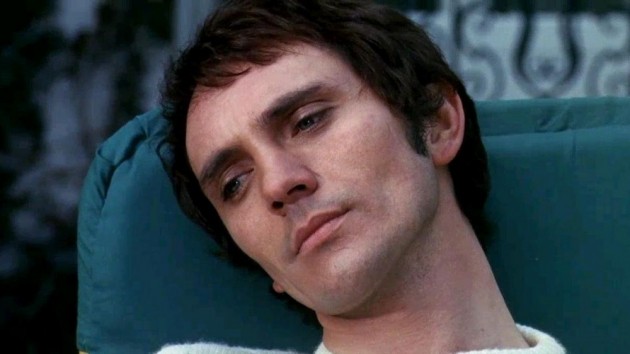
Terence Stamp
After having left his factory, Paolo is seen in the back of a Mercedes driving away. The camera is positioned in such a way that only Paolo’s face is seen and not the chauffeur’s figure, the manual labor behind the wheel, the proletariat. The significance of this shot is that Paolo represents the symbol of repression in a society where only a few who have the means of production define that certain society. Moreover, his socioeconomic status enables him to be the reproductive head of a nuclear family; and thus, his greater resource pool increases the chances for offspring success, bourgeois producing more bourgeois. As the father of this familial sphere, he is the nuclear core that holds the satellite members in place. The effect of the stranger on Paolo is to destabilize him from his view as a natural player in the free market place and a true leader of the family; and as a result of his passion, Paolo realizes that his position in the world is artificial and only defined by his social status in the production and reproduction arenas. This state of awareness causes an accentuated decrease in his confidence, both as a boss and as a father, and leads him to become seriously ill. Indeed, the final outcome of his sickness is to be driven into the desert, permanently marking him with a symbolic death and the disappearance of the bourgeoisie.
In the case of the mother, Lucia, she is first seen in her home reading a book. This shot represents her status in the household as being free from needing to do work, leaving her with lots of leisure time on her hands. As the shot progresses, it is possible to realize that the title of the book she is reading cannot be discerned. Truly, the significance of this unknown book is that Lucia’s position is only formal with no substance. Lucia is a person with an empty existence. Another important shot is when Lucia shows interest in the visitor’s clothes, an image signifying a set of books with readable titles. All this seems to indicate that she realizes a need to fill her own empty and unproductive life; and after her seduction by the stranger, she pursues a series of sexual affairs.
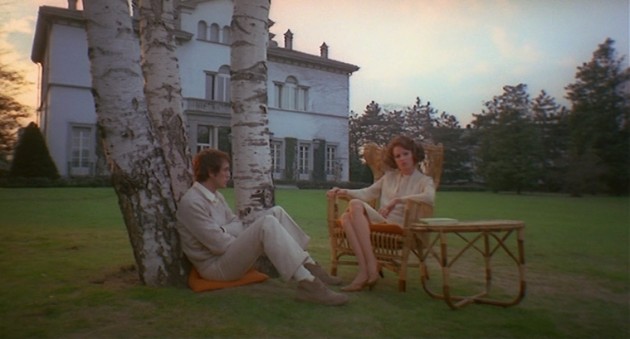
Pietro is a closet homosexual who is in conflict with his heterosexual persona. He tries to be sexually potent like his father but he cannot achieve the same status of power and level of confidence; so he sinks into a relative shyness and lives with an inner rebellious feeling against the established order. Pietro hides his frustrations in the refuge of modern art because it is the only way he can achieve a certain level of individualism. But after the seduction by the stranger, Pietro is seen urinating on his art, and he paints with his eyes closed; and as bizarre as this behavior is, this unconventional artistic originality indicates an individual paranoia that points to the need for autonomy from his family, but also marks his deeply rooted incapacity to move beyond his own mental deadlock.
Odetta is seen with several books pressed against her chest as she walks through a parking lot. This shot indicates that she is a wanderer with something to protect. One of these books is a picture album holding a large photograph of her father which lies within it. This shot suggests that a Freudian Electra Complex is at work within Odetta’s unconscious. It reveals that she has no image of herself, nor any individual self-esteem, because she exists only in the sphere of an all-powerful male figure. Her encounter with the young man is driven by her knowledge of the interaction of her father with the stranger, indicating that she really has no self-reality of her own. After her seduction by the visitor, Odetta is propelled into catatonic non-reality, preferring to reside in a psychiatric hospital instead of living under the umbrella of her controlling father.
Emilia is a key character in the film and represents the hope and aspiration of a society still subjected to the repression of the bourgeoisie. She is an emblem for equitable social growth and psychological healing. She is the only character connected with the working class and significantly, the only one associated with an apparent sacred reality. Emilia unmasks some of the deep beliefs of Pasolini, unveiling his strong feelings for the peasantry and the working class; indeed, it is an indication that he was an orthodox Marxist. Emilia is completely tied into the idea of a “certain realism” and the “disappearance of the sacred from reality.” This view is supported by her failed attempt at suicide, which is an act against the church. It is a mortal sin to kill yourself. Further evidence for a “non-sacred reality” is her miraculous levitation, an act so exaggerated that it is unbelievable. Finally, her almost complete self-burial can be seen as an existentialist statement against religious faith. Emilia is portrayed as anti-bourgeois but nothing more. She is a swallow character because she never talks and is expressionless. All these characteristics make her an absolutely abstract character and introduces an uncertainty in her psycho-social victory. The impact of her encounter with the visitor was tremendous because it literally sent her to her grave; but unlike Paolo, she has the option of resurrection because from her underground deathbed, she is seen gazing out at the world, an indication that there is a possibility for her to live outside the bourgeois system.
On a final note, it is a mistake to believe that the stranger’s visit with this family was something akin to the divine; because in the final analysis, the characters’ indulgences were merely forms of materialism, secular behaviors producing flurries of activities which did nothing to recover their spiritual losses. And as a result, this theorem is a problematic, creating an external convergence point for an existential image of reality and a behavioral leitmotif for the theorematic nature of the film Teorema.
In the case of Salo and an article written by Joel Farges, wherein the theorem is stated as such: “On l’a dit, Sade est irrepresentable. Rien donc de plus anti-sadien qu’un film fabrique a partir de ce texte. Sade, ca se passe hors du reel. Car c’est ailleurs que Sade porte ses efforts dans l’ecrit. La singularite du texte sadien, c’est qu’en definitive l’ecriture elle seule supporte tout Sade” (Farges 184). While Teorema has been considered Pasolini’s pinnacle for a “certain realism,” Salo has never been truly considered in terms of any kind of realism; even though many of the events depicted actually happened in history. It could be said that Salo represents an “uncertain realism.” However, it should be clear that what is being shown in the film is not real and as result, the theorem itself is stagnant and non-problematic, making it an axiomatic statement and nothing more than a dead theorem. And if this argument appears contradictory, let’s remember that Deleuze’s psychomechanics are complicated because they give way to oppositions and inversions, as well as, the possibility of resolutions and convergences.
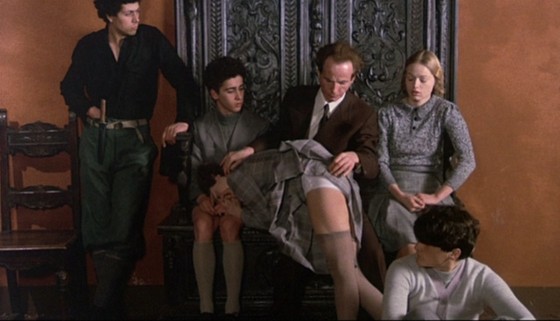
Salo is based on the controversial book by the Marquis de Sade. Pasolini transposes its seventeenth century setting to the 1944 fascist seat of government in northern Italy, where four representatives of power (a magistrate, a president, a judge and a bishop) use “hopelessness” as a political dimension. For no logical reason, they create a set of sadistic laws that would affect the lives of sixteen kidnapped virginal boys and girls, who would be subjected to spiritual and physical death. Pasolini objectively stylizes his horror art film by making the captives expendable merchandise, subjecting their minds and bodies to all kinds of perverted sexual, sadistic and psychopathic degradation. He deliberately purges his work by removing all forms of feeling, psychology, drama, human interaction and social worth. All hope has been removed both from the enslaved and the audience. The major idea used to convey this “unreality” is the technique “to see the delay of death” and the overall experience aimed for is the “lack of beingness.” The credo of Pasolini’s film can be summed up as “excess is good.”
Salo was the location in northern Italy for the Nazi/Fascist satellite government during the occupation. The opening shot shows a natural setting with a beautiful serene atmosphere. However, as the shot unfolds the buildings where the sadistic planning is taking place can be seen in the background. The four magistrates, whom are never named, represent Pasolini’s tremendous contempt for fascism. One of the laws that govern the lives of the imprisoned is the penalty of death for any heterosexual activity. This adjudication makes the whole horrible affair a gigantic ritual of sodomy, an emblem of fascist power politics, total social control, and in effect, human slavery.
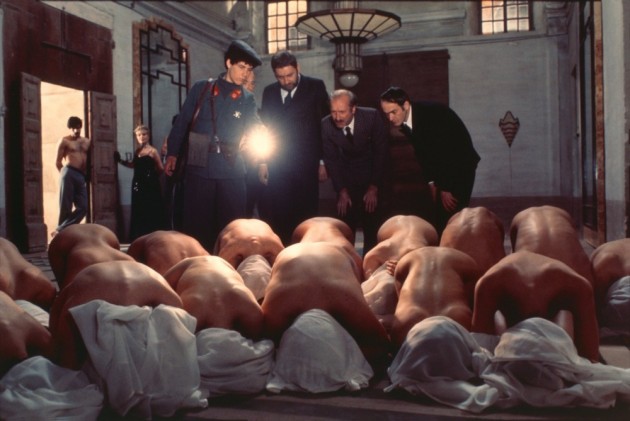
Describing Salo is as meaningless as the theorem itself because all the acts, gestures and maneuvers initiated by the dominators are totally empty, devoid of humanity; and in a sense, they are nothing else but Hitlerian lost causes. But there are some interesting scenes that can be pointed out. For instance, the sequence called “The Circle of Manias,” where the woman, named Signora Vaccari, is seen recounting perverted stories in the ante-chamber. Indeed, these aberrant tales are psychological agents used to stimulate the controllers into sexual activity with their doomed young hostages. Her role appears to bring back a certain amount of reality to these macabre, unreal situations, nudging them out of temporal stasis. These massive orgies seem at times so far removed from reality that they cannot function mechanically, or even initiate physical events. An aura of stagnation seems to continually pervade these secret debaucheries. Another sequence called “The Circle of Excrement,” is so disgusting that it is worth mentioning. It is a sequence that begins with a mock marriage and ends up in a shit eating party. These scenes point to the idea of a consumer society that always has to consume, a Pasolinian anti-capitalist statement. And lastly, the sequence called “The Circle of Blood,” where the only power remaining for the social torturers, before the downfall of such useless regimes, is the power for total destruction and complete social annihilation. It is the ultimate form of human evil, a social malignancy that has no possibility for remission; because after all, these regimes are like the Salo theorem, they have been dead from the beginning, that is, they are stillborn.
On a final note, it can be said that the creative potentials in Teorema are ignored in Pasolini’s last film. Salo is a Pasolinian universe of anti-creation where normal sexual behaviors are forbidden and punished by death, just like all sinful acts are forbidden by the religions in charge. In fact, this dark world brings on its own death because extreme individual liberties seem to always lead to horror, destruction and anarchy; and in the final analysis, humans need a certain amount of self-control, and that is the meaning of Salo’s dead theorem.
To conclude, let’s just say that Teorema may not save its characters from a life of misery, but at least, it allows them to live their lives out freely; and because its theorem is problematic, it attempts to answer some deeply moving questions. For Salo that is not the case, its characters are not only miserable, they suffer throughout the film; and even after the final torturous massacre, the ones that remain alive are as dead as the slaughtered victims. Salo does not solve any problems nor even attempts to pose any questions, it is simply a statement of death.
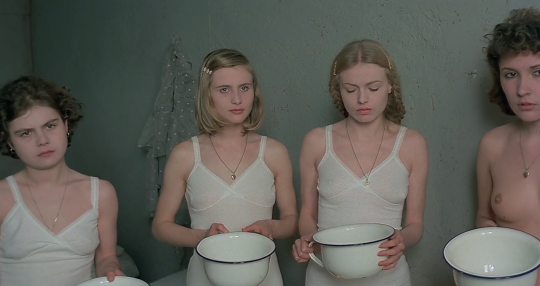
SELECTED BIBLIOGRAPHY
Bachmann, Gideon, “Pasolini in Persia: The Shooting of 1001 Nights.” Film Quarterly, Winter 1973-74, Volume XXVII, No. 2, pp. 25 – 28.
Bachmann, Gideon. “Pasolini and the Marquis de Sade.” Sight and Sound, Winter 1975/76,
Volume 45, No. I, pp. 50 – 54.
Bachmann, Gideon. “Pier Paolo Pasolini’s Salo: No rationales, no alibis.” Take One, 1976,
Volume 5, Number 1, pp. 29.
Bachmann, Gideon. “Pasolini: A Critic’s Journal/The 220 Days of ‘Salo,’ Pasolini’s Last Film.”
Film Comment, March-April 1976, Volume 12, Number 2, pp. 38 – 47.
Bonitzer, Pascal. “Pasolini: Teorema, Le carre.” Cahiers du Cinema, April, 1969, No.211, pp. 53.
Bordwell, David and Kristin Thompson. Film Art: An Introduction. Sixth Edition. New York: McGraw-Hill, 2001.
Buchanan, Ian and Claire Colebrook, eds. Deleuze and Feminist Theory. Edinburgh: Edinburgh
University Press Ltd, 2000.
Cesare, Tony. “Pasolini’s Theorem.” Film Criticism, Fall 1989, Vol. XIV, No. 1, pp. 22 – 25.
Chatman, Seymour. Antonioni or, the Surface of the World. Berkeley and Los Angeles, California & London, England: University of California Press, Ltd., 1985.
Cook, David A. A History of Narrative Film. Third ed. New York and London: W. W. Norton & Company, Inc., 1996.
Crick, Philip. “Pasolini: Philosophy of Cinema.” Cinema. London and Cambridge: Greengage Productions & Rostrum Publications, August 1970, No. 6 & 7, pp. 13.
Daney, Serge. “Pasolini: Teorema, Le desert rose.” Cahiers du Cinema, May 1969, No. 212, pp. 61 – 62.
Deleuze, Gilles. Cinema 1: The Movement-Image. London: The Athlone Press, 1986.
Deleuze, Gilles. Cinema 2: The Time-Image. Minneapolis: University of Minnesota Press, 1989.
Denby, David, ed. Film 70/71: An Anthology by the National Society of Film Critics. New York: Simon and Schuster, 1971.
Esteve, Michel, ed. “Pier Paolo Pasolini (1): le mythe et le sacre.” Etudes Cinematographiques, July – December/1976, No. 109 – 111, pp. 3 – 103.
Esteve, Michel, ed. “Pier Paolo Pasolini (2): un cinema de poesie.” Etudes Cinematographiques, January – June/1977, No. 112 – 114, pp. 107 – 219.
Goodchild, Philip. Deleuze and Guattari: An Introduction to the Politics of Desire. London, New Delhi and Thousand Oaks, California: Sage Publications Inc., 1996.
Greene, Naomi. “Reading Pasolini Today.” Quarterly Review of Film Studies, Spring 1984, Volume 9, Number 2, pp. 143 – 148.
Giguere, Andre. “Pasolini: Salo et le Fascisme.” Sequence/Revue de Cinema, January 1982, No. 107, pp. 20 – 25.
Kennedy, Liam. Susan Sontag: Mind as Passion. Manchester and New York: Manchester University Press, 1995.
Mast, Gerald, Marshall Cohen, and Leo Braudy. Film Theory and Criticism: Introductory Readings. Fourth ed. New York and Oxford, England: Oxford University Press, 1992.
Neupert, Richard. “A Cannibal’s Text: Alternation and Embedding in Pasolini’s Pigsty.” Film Criticism, Spring 1988, Vol. XII, No. 3, pp. 46 – 57.
Pasolini, Pier Paolo. “The Cinema of Poetry.” In Movie and Methods, Edited by Bill Nichols (Berkeley, 1976).
Pasolini, Pier Paolo. “The Scenario as a Structure Designed to Become Another Structure.” Wide Angle of Theory, Criticism and Practice. 1977, Vol. 2, No. 1, pp. 41 – 47.
Pasolini, Pier Paolo. Teorema. Second ed. Milan, Italy: Garzanti Editore s.p.a., 1994.
Patton, Paul, ed. Deleuze: A Critical Reader. Oxford and Cambridge, Massachusetts: Blackwell Publishers, Ltd, 1996.
Purdon, Noel. “Pasolini: The Film of Alienation.” Cinema. London and Cambridge: Greengage Productions & Rostrum Publications, August 1970, No. 6 & 7, pp. 14 – 21.
Stewart, Garrett. “Exhumed Identity: Antonioni’s Passenger to Nowhere.” Sight and Sound, Winter 75/76, Volume 45, No. I, pp. 36 – 40.
Tudor, Andrew. “Antonioni: The Road to Death Valley.” Crick, Philip. Cinema. London and Cambridge: Greengage Productions & Rostrum Publications, August 1970, No. 6 & 7, pp. 22 – 30.
Thirard, Paul-Louis. “La Mystique et la Gambade (Teorema).” Positif, April 1969, No. 104, pp. 39 – 44.
Viano, Maurizio. A Certain Realism: Making Use of Pasolini’s Theory and Practice. London, England, Los Angeles and Berkeley, California: University of California Press, 1993.



-small_400_258_90_s_c1.jpg)
_2_400_258_90_s_c1.jpg)
